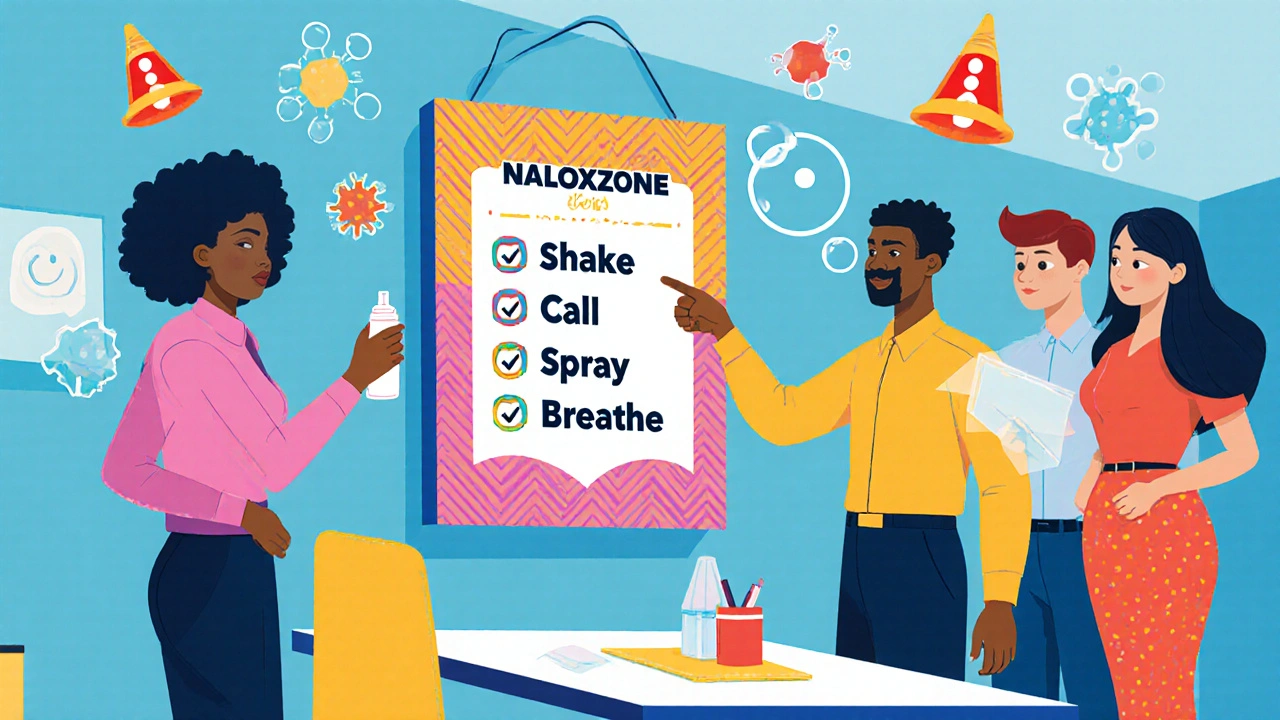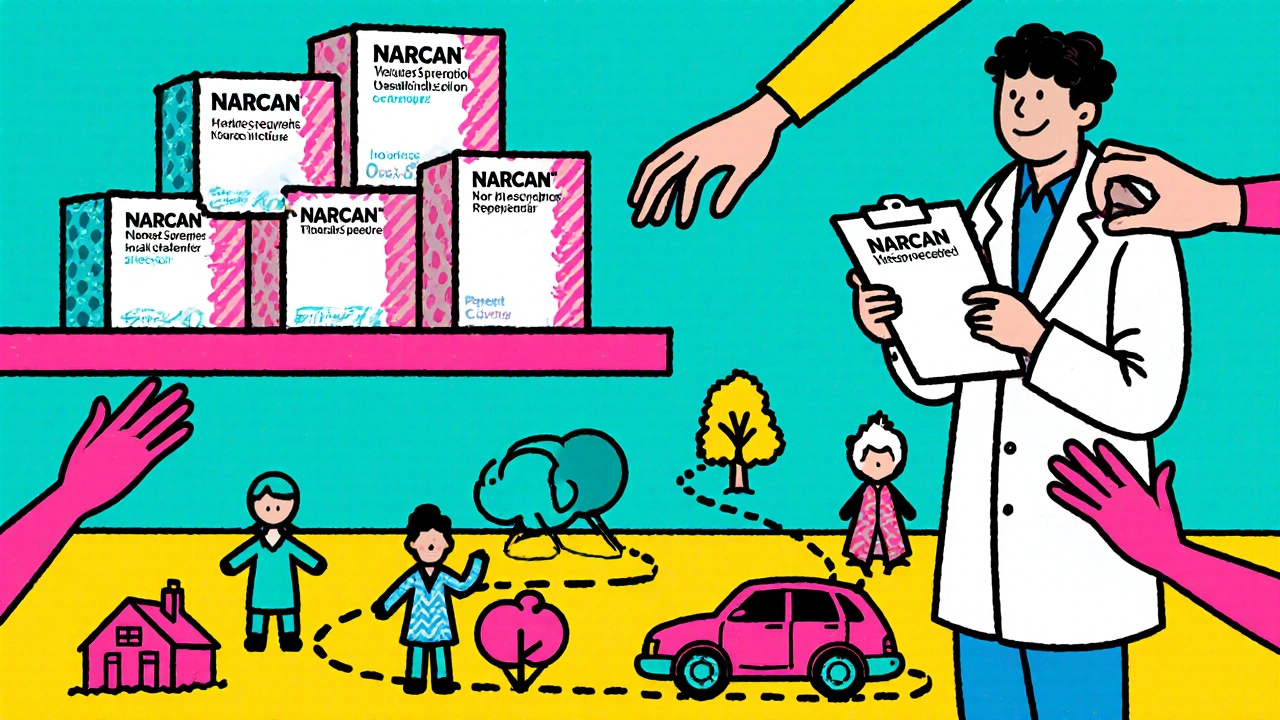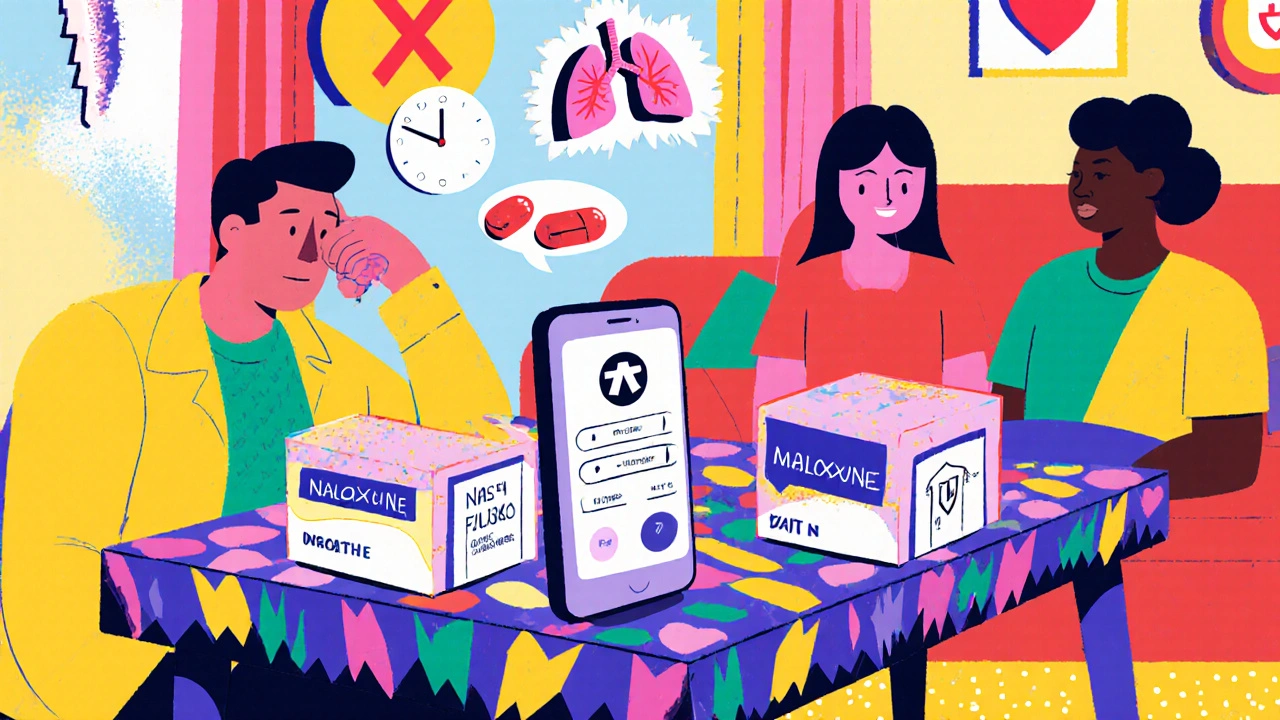Naloxone Readiness Calculator
Create Your Personalized Naloxone Readiness Plan
This tool helps determine how many naloxone kits you need based on your situation and recommends best practices for overdose response.
Your Naloxone Readiness Plan
Emergency Reminder: If you suspect an opioid overdose:
1. Call 911 immediately
2. Give naloxone if available
3. Start rescue breathing (tilt head back, lift chin, give breaths every 5 seconds)
4. Stay with the person until help arrives
Every year, thousands of people die from opioid overdoses - not just those using street drugs, but also people taking prescribed pain meds exactly as directed. The truth is, naloxone doesn’t just save lives in emergency rooms. It saves them in homes, workplaces, and clinics - if it’s ready when you need it. A naloxone readiness plan isn’t optional for anyone managing opioid therapy. It’s the difference between a preventable death and someone going home to their family.
Why Naloxone Isn’t Just for Drug Users
Many assume naloxone is only for people with addiction. That’s a dangerous myth. In 2022, the CDC found that 86.7% of opioid overdose deaths occurred in people who weren’t currently prescribed opioids. But that doesn’t mean prescriptions aren’t part of the problem. Nearly 4 in 10 opioid overdose deaths involved prescription opioids alone. People on long-term pain meds - especially those taking more than 50 morphine milligram equivalents per day - are at real risk. Their bodies adapt. Their tolerance rises. A missed dose, a new medication, or even a bad night’s sleep can tip the balance. Naloxone doesn’t care if someone has a substance use disorder. It only responds to opioids in the system. If there are opioids, it reverses them. If there aren’t, it does nothing. No harm. No high. No addiction potential. It’s a safety net, not a judgment.How Naloxone Actually Works
Naloxone works like a key that fits better than the original lock. Opioids bind to receptors in the brain that control breathing. When too many opioids are present, breathing slows - or stops. Naloxone rushes in and kicks those opioids off the receptors. Within 2 to 5 minutes, breathing returns. It’s fast. It’s simple. But it’s not permanent. The problem? Naloxone wears off in 30 to 90 minutes. Many opioids - especially fentanyl and its deadly cousins - last much longer. That means someone can wake up after one dose of naloxone, feel fine, and then slip back into overdose an hour later. This is called renarcotization. It’s why calling 911 isn’t optional. It’s non-negotiable. And it’s not just about the dose. Fentanyl is so potent that one overdose can require 2, 3, or even 10 doses of naloxone. The standard 4mg nasal spray might not be enough. That’s why having multiple kits on hand matters.What a Real Naloxone Readiness Plan Looks Like
A readiness plan isn’t just keeping a box in the medicine cabinet. It’s a system. Here’s what it includes:- Two or more naloxone kits - One for home, one for the car or workplace. The American Academy of Family Physicians recommends at least two doses per patient on long-term opioids. For rural areas or workplaces with longer emergency response times, keep more.
- Immediate access - The kit must be reachable within 30 seconds. Not tucked in a drawer. Not locked in a cabinet. Not buried under laundry. If someone’s not breathing, you don’t have time to search.
- Clear instructions - Print them. Tape them to the kit. Record a voice note on your phone. People panic in emergencies. Simple, visual steps save lives.
- Training for everyone - Not just the patient. Family members, caregivers, coworkers. The National Safety Council found that 20 minutes of hands-on practice leads to 92% correct use. Without training, even the best kit is useless.
- Know the signs - Unresponsive. Slow or no breathing. Blue lips or fingertips. Pinpoint pupils. If you see these, assume overdose. Don’t wait for confirmation.

Which Naloxone Form Is Right for You?
There are three main types:| Form | Dose | Cost (without insurance) | Best For |
|---|---|---|---|
| Nasal Spray (NARCAN®) | 4mg per spray | $130-$150 | Home, family use, non-medical users |
| Intramuscular Vial + Syringe | 0.4mg per vial | $25-$40 per dose | Healthcare settings, trained users |
| Auto-injector (Evzio®) | 2mg or 4mg | $3,200 (after price cuts) | High-risk patients with limited dexterity |
What to Do When Someone Overdoses
Time is everything. Here’s the exact sequence:- Check for response - Shake and shout. If they don’t wake up, assume overdose.
- Call 911 immediately - Even if you give naloxone, they still need medical care. Tell the dispatcher it’s a suspected opioid overdose.
- Give naloxone - For nasal spray: insert the nozzle into one nostril, press the plunger all the way down. Don’t be gentle. Push hard. For injection: inject into the outer thigh, even through clothing.
- Start rescue breathing - Tilt the head back, lift the chin. Give one breath every 5 seconds. This keeps oxygen flowing until they start breathing on their own. Studies show brain damage can begin in under 3 minutes without oxygen.
- Wait and watch - If they don’t respond in 2-3 minutes, give a second dose. Stay with them. Monitor breathing. Even if they wake up, they can crash again. Keep them awake. Keep talking. Don’t let them sleep.
- Stay until EMS arrives - Don’t assume they’re safe. Naloxone’s effects fade. The opioid doesn’t.

Why So Many People Still Don’t Have Naloxone
Despite all the progress, only 53% of Americans know where to get it. In the South, that number drops to 42%. Why? Stigma is the biggest barrier. Doctors still hesitate to talk about naloxone with patients, fearing they’ll be seen as encouraging drug use. But data shows the opposite. When providers offer naloxone, patients are more likely to take their medications safely and follow up on care. Cost is another issue. Even with standing orders in 33 states, 42% of uninsured people say they can’t afford it. Some states offer free kits through public health programs. Check with your local health department. Community pharmacies, harm reduction centers, and even some churches now distribute naloxone for free. And then there’s awareness. Many people don’t realize naloxone is now available without a prescription. They think they need to see a doctor. They don’t. Walk into any pharmacy. Ask for NARCAN®. It’s on the shelf.What’s Changing in 2025
The landscape is shifting fast. The Biden administration now requires naloxone to be available in all federal buildings by December 2024. The FDA is reviewing new nasal sprays with longer-lasting effects. More states are passing laws to require naloxone in schools, libraries, and public transit hubs. Workplaces are catching up too. Since 2011, workplace overdose deaths have jumped 619%. OSHA now recommends naloxone in any workplace with 15 or more employees. That means your office, your factory, your warehouse - all should have a kit. And the most important shift? Naloxone is no longer seen as a last resort. It’s becoming part of standard care - like having an AED in a gym or an epinephrine pen for allergies. It’s a precaution. A safety tool. A sign that someone cares.Final Thought: This Isn’t About Fear. It’s About Responsibility.
If you’re on opioids - whether for chronic pain, cancer, or recovery - you have a right to safety. But safety doesn’t come from hope. It comes from preparation. Keep naloxone where you can reach it. Teach someone how to use it. Carry an extra kit in your bag. Talk about it. Not in hushed tones. Not with shame. But plainly. Like you’d talk about seatbelts or smoke detectors. Because the next time someone stops breathing, it won’t be a stranger. It might be your partner. Your parent. Your child. Or you. Don’t wait for the moment to decide if you’re ready. Be ready now.Can naloxone be used on someone who didn’t take opioids?
Yes, but it won’t do anything. Naloxone only works if opioids are present in the system. If someone overdosed on alcohol, benzodiazepines, or cocaine, naloxone has no effect. It won’t harm them. It won’t cause a reaction. It’s completely safe to administer if you’re unsure - better to give it and find out later than wait and risk death.
How long does naloxone last, and why does that matter?
Naloxone lasts between 30 and 90 minutes. Many opioids - especially fentanyl - last much longer. This means a person can wake up after one dose of naloxone, feel fine, and then slip back into overdose. That’s why you must call 911 even after giving naloxone. The person needs to be monitored for at least 2-3 hours, and multiple doses may be needed.
Do I need a prescription to buy naloxone?
No. Since September 2023, NARCAN® nasal spray has been available over the counter at pharmacies like CVS, Walgreens, and Walmart. No ID, no prescription, no questions asked. You can buy it just like you would buy pain relievers or allergy medicine.
Can I give naloxone to a stranger?
Yes. In all 50 states and Washington D.C., Good Samaritan laws protect people who administer naloxone in good faith during an emergency. You cannot be sued or charged for helping. If someone is unresponsive and not breathing, give naloxone and call 911. Your action could save a life - and you’re protected by law.
What if I don’t know how to use the nasal spray?
The nasal spray is designed to be used by anyone. The device clicks when properly inserted. You just press the plunger firmly - no twisting, no aiming. Most kits come with printed instructions and even QR codes linking to short demo videos. Practice once with an expired kit. It takes less than 30 seconds. In an emergency, you’ll know exactly what to do.
Is naloxone effective against fentanyl?
Yes, but it often requires more than one dose. Fentanyl is 50 to 100 times stronger than morphine. A single 4mg nasal spray may not be enough. If the person doesn’t respond after 2-3 minutes, give a second dose. In some cases, up to three or four doses may be needed. Always call 911 - multiple doses mean the overdose is severe and requires professional care.
Where can I get free naloxone?
Many local health departments, community clinics, and harm reduction organizations offer free naloxone kits. Some pharmacies give them out for free under state programs. In states like Georgia, South Carolina, and Oklahoma, thousands of free kits have been distributed. Search online for “free naloxone near me” or contact your state’s health department. If you’re on Medicaid or Medicare, ask your pharmacy - many cover it with no copay.

